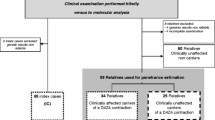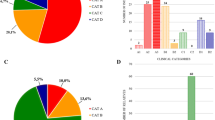Abstract
Facioscapulohumeral muscular dystrophy (FSHD) is an autosomal dominantly inherited neuromuscular disorder affecting facial and shoulder girdle muscles with subsequent progression to the pelvic girdle and lower extremities. The major gene involved has been localized to chromosome 4q35 (FSHD1A). The 4q35 DNA marker p13E-11 (D4F104S1) detects a de novo EcoRI DNA rearrangement of < 30 kb in isolated and familial cases. The intrafamilial size of the fragment is constant, inversely correlated with the severity, and directly correlated with the age of onset of the condition. There has been evidence of parental mosaicism in FSHD1A for the D4F104S1 locus. Four female and three male clinically unaffected parents have been described to be carriers of EcoRI fragments of the same size as their affected offspring, but with a markedly less intensive hybridization signal (semi-quantitative evidence). In our total sample of 42 FSHD1A families, we found semi-quantitative evidence of parental D4F104S1 mosaicism in 11 families (EcoRI fragment size range: 12–27 kb). On analysis with adjacent 4q35 probes (D4S163, D4S139), additional qualitative evidence of germline mosaicism could be obtained in two families. In our mosaic families and in the families reported in the literature, a female predominance of mosaicism carriers (13 females versus 5 males) could be noted. In our sample, mosaicism was observed in multigeneration families, in families with isolated cases, and in families with two and three affected children from seemingly unaffected parents. A short EcoRI fragment once having emerged in a mosaicism carrier was found to be transmitted autosomal dominantly to subsequent generations. Of all reported sporadic patients, 19% have a mosaic parent. Finding evidence of parental mosaicism in all our families with more than one affected child of seemingly unaffected parents suggests that there is no autosomal recessively inherited form of FSHD1A.
Similar content being viewed by others
Author information
Authors and Affiliations
Additional information
Received: 5 March 1996 / Revised: 14 May 1996
Rights and permissions
About this article
Cite this article
Köhler, J., Rupilius, B., Otto, M. et al. Germline mosaicism in 4q35 facioscapulohumeral muscular dystrophy (FSHD1A) occurring predominantly in oogenesis. Hum Genet 98, 485–490 (1996). https://doi.org/10.1007/s004390050244
Issue Date:
DOI: https://doi.org/10.1007/s004390050244




